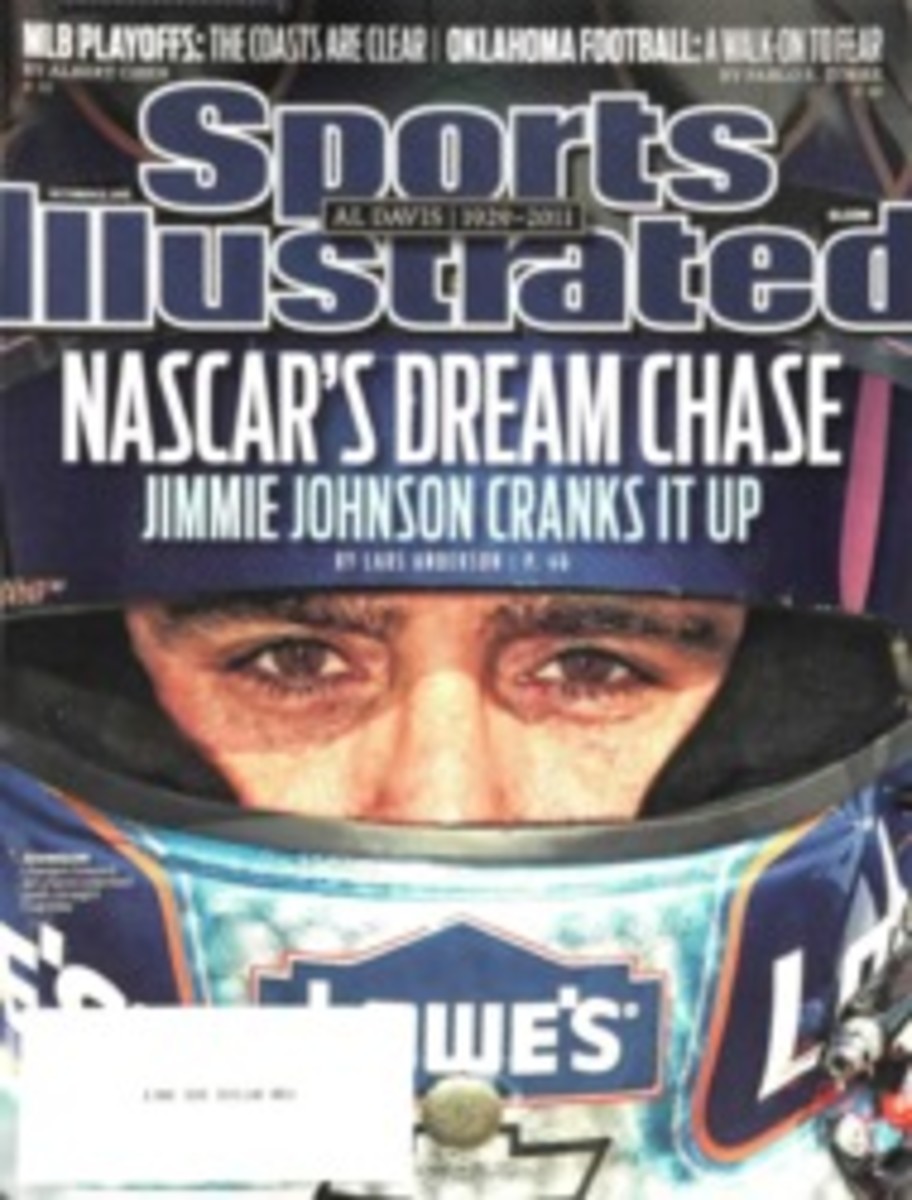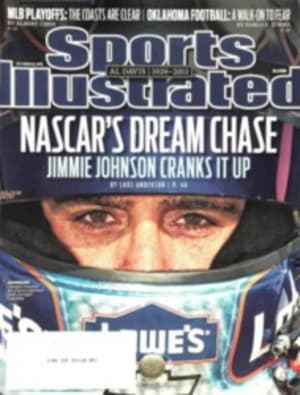
AL DAVIS 1929--2011
The Raiders' patriarch did it his way for nearly five decades, running a renegade outfit that inspired loyalty and instilled fear, forever at war with his fellow owners. And yet, though he remained a rebel to the end, he will be remembered best as one of the pillars of the modern NFL
Toward the end he mocked his own mystique, the great Al Davis tootling around the practice field in a golf cart, conducting press conference tirades with the aid of an overhead projector and just generally interfering with any possibility of the Raiders' success. His theories—now, what was the vertical passing game again?—had become as dated as his silver-and-black jumpsuits; his grasp of NFL personnel as quaint as his thinning ducktail. He was painfully out of style, step, sync and touch. When he died last Saturday at the age of 82, his once fearsome band of buccaneers hadn't finished with a winning record in nearly a decade, and his enemies, of whom he'd made a few, had long been enjoying his comeuppance, safely snickering at the toothless snarl.
To which we say, My, what short memories. In his day, which was longer than those enemies might be comfortable admitting, Davis not only dominated the game with his madcap misfits but also wrote the rules by which everyone, enemies included, ended up playing. In fact, his 48-year legacy as the Raiders' coach and later general manager (like the Yankees' George Steinbrenner, Davis assumed "ownership" without quite owning his team) may be the least of it, although those accomplishments can't be dismissed.
There was a period, after all, when the Raiders were simply the most successful team in professional sports. From 1963, when Davis joined the franchise as its head coach (after assistant stints with Adelphi, the Citadel, USC and the Chargers), through 1994, long after he'd named himself G.M., the Raiders were 304-159-11, with victories in Super Bowls XI, XV and XVIII. And Davis's Raiders won it with a panache that fully justified their skull-and-bones fashion line: Using castoffs (Lyle Alzado, John Matuszak, Jim Plunkett) and overlooked prospects (Fred Biletnikoff, Howie Long)—"He never had normal players," said Tom Keating, a defensive tackle during the glory years—Davis brought a heightened sense of physical jeopardy to the game. As he once said (when he wasn't saying, "Just win, baby"), he would rather be "feared than respected."
And Davis was, although not only for the physical mayhem that players like safety Jack (the Assassin) Tatum and linebacker Ted (the Mad Stork) Hendricks visited on their comparatively milquetoast opponents. Davis's dedication to winning was so exaggerated that rivals felt certain he was capable of almost anything. If he was willing to hang around celebrity golf tournaments to gauge the availability of prospects, what else might he do? He was a paranoia generator who moved opposing coaches to shake their fists at hovering helicopters and suspicious light bulbs, to wonder if their scouts' phone calls were really being redirected to Davis's hotel room. Did any of these things actually happen? Didn't matter; somebody thought they did.
It was, really, Davis's preference for mischief that transformed the game, even more than his rogue ideas for developing juggernaut teams. Just three years into his head coaching career, the upstart AFL, realizing it could only survive by merging with the NFL, identified Davis's talents for provocation and installed him as its commissioner. A certain commotion ensued. Davis ran wild, signing seven starting NFL quarterbacks to AFL contracts, snapping up college stars, driving salaries through the roof until the NFL had nothing left to do but admit the renegades. Of course, by then Davis was more interested in crushing the NFL than joining it; the other AFL owners kept him out of the final negotiations, afraid he'd quash the merger, which had been the whole point after all. So that now we have—what do you call it?—the Super Bowl.
Even with this victory, Davis was far from an NFL man, always the 1 in those 27--1 or 31--1 votes. He was too devoted to his Raiders, far too competitive to acknowledge a communal good. When, in 1980, he determined that the Raiders' prospects would be better served in a more profitable stadium, he sued the NFL and won, moving the franchise to Los Angeles for the 1982 season. This was an unforgivable assault on the establishment—and it didn't help that the Raiders continued to win, forcing commissioner Pete Rozelle into an awkward Super Bowl trophy presentation the next season—but, as was the case with most of Davis's unforgivable assaults, it turned out to be quite prescient. One by one other owners began to tap the value of their teams, leveraging the threat of leaving into a new stadium or finding gold in Indianapolis, Phoenix or, well, back in Oakland. Wherein a Davis tantrum became a league template.
Still, as much as he enjoyed messing with institutional authority (in later years, it must be noted, he became somewhat trusted, even admired, by his NFL brethren as they beheld the wealth of his ways), it was always about the Raiders. His vanity was somewhat comic; he was a man, after all, who kept free weights near his office so he could maintain his "lines." But he never confused his ego for pride in his team. His loyalty to his players—whether expressed in giant Super Bowl rings, silent bequeathals to ailing alumni or simply the competitive advantage of better travel—was a running theme. He was a man, former Raiders running back Bo Jackson said, "who would have fought a lion with a switch to defend his players."
Players or—in later years as he wrestled with failure—coaches who didn't get on board often paid a price. Star running back Marcus Allen fell from favor after a 1989 contract holdout, and Mike Shanahan, the first in a string of fired coaches, probably didn't get a Christmas card. We mentioned Davis had enemies, right? But overwhelmingly the evidence is in favor of a unique player-owner bond. When those old Raiders were inducted into the Hall of Fame—and thanks to Davis's stubborn scouting there were a bunch—they asked for Al to present them.
Maybe it didn't end the way he wanted, big-armed quarterbacks and scorching wideouts no longer the ticket, but it's become clear, even to his enemies, that Davis's life of pompadoured insubordination trended toward righteousness, maybe even justice. Forget the Super Bowls, the path he made for the modern-day NFL. Just doing the right thing, he broke down barriers, hiring the first Hispanic coach, Tom Flores, the first black coach of the modern era, Art Shell, the first woman executive, Amy Trask. He thought it could help him just win, baby.
It would probably kill him, if he weren't already dead, but it's more than likely that Al Davis will be remembered as a pioneer, not a scoundrel, as a league icon rather than an iconoclast. It's more than likely he'll be respected—he'd really hate this—long after he was feared.
SCENES IN SILVER AND BLACK
Clockwise from above: Super Bowl XI offensive linemen Gene Upshaw, Art Shell, Dave Dalby, George Buehler and John Vella; Davis receives the Super Bowl XV trophy from Pete Rozelle; happier days with Marcus Allen, with whom he later feuded; Fred Biletnikoff and Ken Stabler celebrate the Super Bowl XI win; a sideline sage in Oakland; with AFL All-Stars (from left) Tommy Morrow, Fred Williamson, Archie Matsos, Clem Daniels, Jim Otto and Art Powell; coaching at Youell Field in '63; Upshaw and John Madden after Super Bowl XI.
PHOTO
GEORGE GOJKOVICH/GETTY IMAGES (DAVIS)
STYLE, SUBSTANCE From his scouting of historically black colleges to his fight over the right to move his team, Davis (here in 1977) left a distinctive imprint on the game.
THREE PHOTOS
DAVID N. BERKWITZ
TWO PHOTOS
CURT GUNTHER
OLD SCHOOL In '63, his first year as Raiders coach, Davis game-planned with Art Powell (84) and Ken Herock (86) and gave Fred Williamson (above) pointers.
PHOTO
DENNIS DESPROIS/WIREIMAGE.COM (LINEMEN)
PHOTO
BETTMANN/CORBIS (ROZELLE)
PHOTO
RICHARD MACKSON (MARCUS ALLEN)
PHOTO
AP (BILETNIKOFF/STABLER)
PHOTO
CURT GUNTHER (BENCH)
PHOTO
ROBERT KLEIN/AP (ALL-STARS)
PHOTO
RON RIESTERER/OAKLAND TRIBUNE/MCT/LANDOV (SIDELINE)
PHOTO
NEIL LEIFER (UPSHAW/MADDEN)

